AI in education is no longer a futuristic concept; it is today’s most powerful equaliser. From arts to commerce, every student now learns, experiments, and creates in an AI-enabled world. The classrooms of tomorrow have arrived early, and those who adapt will lead the AI in India.
The World Economic Forum’s Future of Jobs 2025 report reveals that 96% of Indian organisations are already implementing AI programs. Most learned scholars too, reinforces that every student must master AI tools like ChatGPT and prompt engineering.
As Co-Founder of TrendVisionz, working with leading education and travel clients has given us firsthand insight into this transformation. Students who merge creativity with AI literacy are building global-ready portfolios. This trend is seen in Study Abroad Trends 2025.
This article explores how AI is reshaping education, skill development, and employability. If you are someone eager to stay ahead in this evolving landscape, this in-depth article is written for you.
Also Read:
- QS Rankings Explained: How Top Universities Are Ranked Worldwide
- Mobile-First Indexing: What You Should Know
What Is AI in Education?
Artificial Intelligence in Education oftne called AIEd, refers to the use of intelligent technologies such as machine learning, data analytics, and generative AI to enhance learning experiences and teaching outcomes. AIEd enables personalized, adaptive, and data-driven education that meets each student’s individual pace and learning style.
What Is the Origin of AI in Education?
The concept of AI in education dates back to the 1960s with PLATO (Programmed Logic for Automated Teaching Operations). PLATO is one of the earliest computer-based instruction systems developed at the University of Illinois. From these beginnings, AIEd has evolved from simple programmed responses to today’s dynamic tools like ChatGPT, Gemini, and AI-powered assessment systems that support real-time feedback and creativity.
What Are the Leading AI Tools in Education?
Artificial Intelligence is now shaping how students learn, practice, and collaborate. Colleges and hospitals are working together to bring AI and robotics into healthcare training early. Students now learn with real robotic systems and AI tools in labs. From conversational support to adaptive tutoring, these tools bring real-world applications into classrooms worldwide.
Popular AI Tools in Learning:
- ChatGPT (OpenAI) – Assists with explanations, essays, and creative thinking, helping students express and refine ideas.
- Gemini (Google) – Simplifies research, visual understanding, and language translation through AI-powered insights.
- Perplexity AI – Offers trustworthy, sourced answers that teach students how to research and think critically.
- NotebookLM (Google) – Helps organize notes, summarize readings, and create personalized study guides.
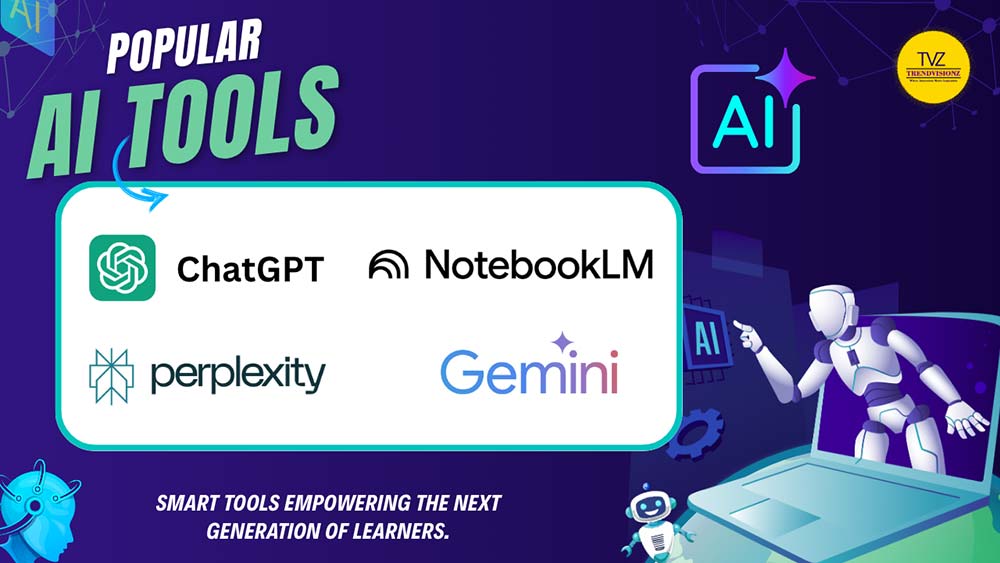
AI tools like ChatGPT and Gemini are redefining learning—making it conversational, personalized, and accessible for every learner.
How Is AI Used in Modern Classrooms?
Modern classrooms now use AI for predictive analytics, immersive simulations, and language inclusivity. The goal remains clear—to make education more accessible, efficient, and human-centered across all disciplines.
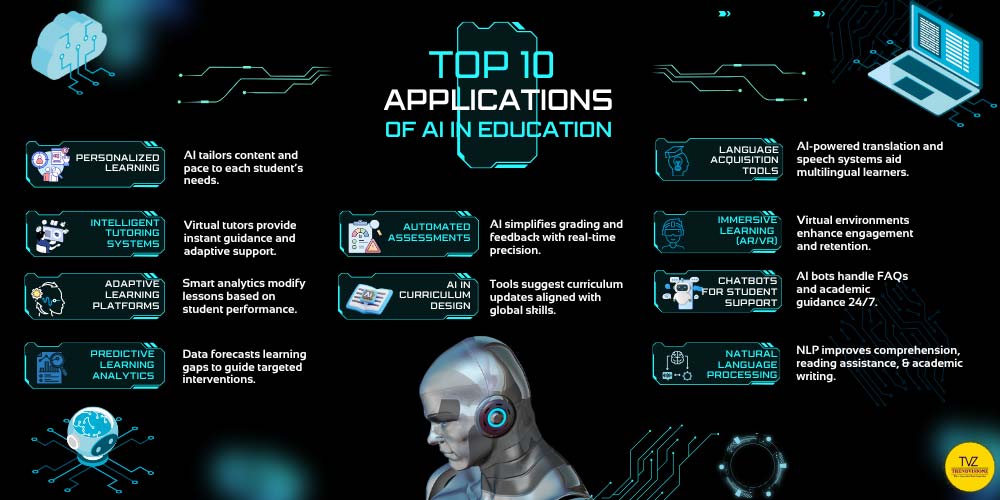
Key Takeaway: AI in education transforms learning into a personalized, inclusive, and globally connected experience—bridging creativity, data, and technology to prepare every student for the future of work.
Why AI in Education Matters More Than Ever
AI is transforming classrooms into personalized, data-driven learning environments. The benefits of AI in education extend beyond automation—it is redefining how teachers teach and how students think, collaborate, and grow.
How does Artificial Intelligence in Learning create real impact?
According to UNESCO and Statista, the global education1 AI market has grown by more than 45% in the last three years, with schools increasingly adopting intelligent tutoring systems and adaptive assessments. This shift is helping bridge the urban–rural learning gap by making personalized education accessible even in remote regions.
UNESCO is committed to helping countries harness the power of artificial intelligence to achieve the Education 2030 Agenda, ensuring that every application of AI in education upholds inclusion, equity, and human-centred values — UNESCO
The U.S. Department of Education’s AI and the Future of Teaching and Learning report emphasizes transparency, teacher preparedness, and ethical AI adoption to ensure technology supports creativity, trust, and human connection in classrooms.
How Are Institutions Implementing AI in Classrooms?
India’s leading institutions are echoing this vision. IIM Sambalpur, one of the country’s premier management institutes, has introduced AI-enabled learning to transform how students and teachers interact in classrooms. Commemorating its 10th Foundation Day, the institute highlighted a decade of innovation and inclusiveness in management education.
We are announcing the implementation of AI in classrooms for a transformative learning experience. The role of the teacher will evolve from teaching to creating and learning.- Prof. Mahadeo Jaiswal, Director, IIM Sambalpur
This initiative aligns with India’s larger vision of integrating technology, experiential learning, and global collaboration in higher education.
Key benefits of AI in education
What I have personally observed in my agency work is that the benefits of AI in education go far beyond convenience. They are redefining how knowledge is delivered, experienced, and retained. Artificial intelligence in learning enhances understanding, accessibility, and engagement through adaptive technology and data-driven insights.
- Personalized Learning: Adaptive platforms tailor lessons to each student’s pace and capability.
- Real-Time Feedback: Teachers and learners receive instant performance updates.
- Language Inclusion: AI translation tools foster multilingual accessibility.
- Targeted Support: Predictive analytics detect gaps and guide timely intervention.
Working with diverse industry clients and edtech startups, I’ve witnessed how artificial intelligence in learning sharpens both efficiency and curiosity. It changes how students approach knowledge itself. People no longer chase quick answers—they ask sharper questions and think in layers. This shift mirrors our own digital behavior, where SEO in the age of AI is becoming more intuitive, conversational, and intent-driven.
Key Takeaway: AI is not replacing education—it is redefining it. By combining automation with empathy, it gives educators time to focus on creativity and critical thinking, while ensuring that every learner can access quality knowledge at their own rhythm. The true benefit of AI in education lies in accessibility and adaptability
The Future of Jobs 2025 – Preparing for the AI Economy
The World Economic Forum’s Future of Jobs 2025 report paints a clear picture of where the global workforce2 is heading. AI and automation are not just transforming technology roles—they are rewriting every job description.
Careers across design, finance, healthcare, and education now demand at least a basic understanding of AI tools and digital workflows. The ability to adapt, collaborate, and apply creativity with technology is what will separate future leaders from followers.
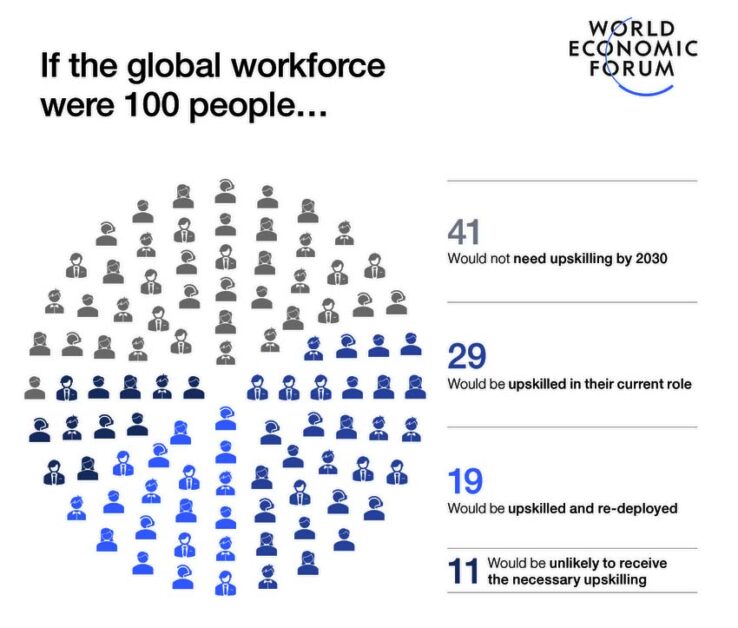
AI Career Opportunities Across Industries
The demand for AI skills is accelerating across sectors. From data analytics and content design to marketing automation and AI ethics, companies are actively seeking talent that understands how to blend creativity with computation. Even traditionally non-technical roles—like HR, finance, or project management—now depend on intelligent systems for insights and decision-making.
Working with young professionals in my agency experience, I often compare this to building wealth early. Just as explained in Financial Discipline in Your 20s, investing in AI skills now compounds over time. Turning small experiments today into significant career advantages tomorrow. The earlier students start learning AI, the more exponential their professional growth becomes.
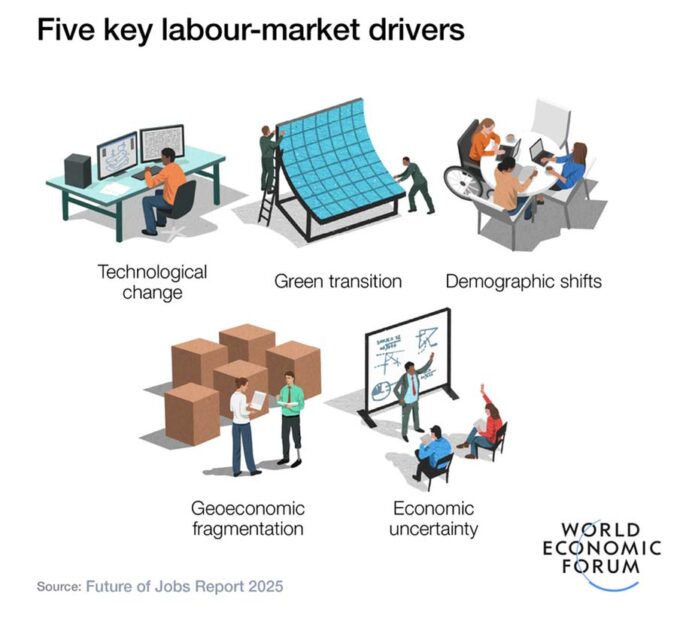
What Are the Key Future-Ready Skills for Students?
The future of jobs will favour students who blend human intelligence with technological fluency. Developing AI skills early ensures adaptability and long-term growth across industries. Key future-ready skills include:
- Critical Thinking: Analysing data and drawing meaningful conclusions.
- Creative Problem-Solving: Using technology to design innovative solutions.
- Collaboration: Bridging teamwork across digital and physical spaces.
- Ethical Awareness: Applying responsibility in AI use and data handling.
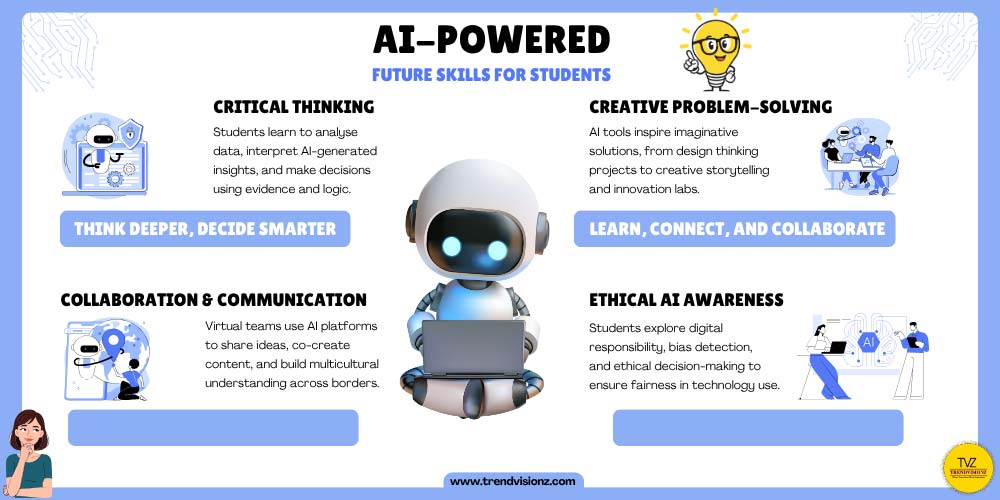
These skills turn knowledge into value—helping students remain employable and future-ready in an AI-driven economy. AI is creating more opportunities than it replaces. Those who learn to connect human insight with digital intelligence will not just survive the future of work—they will define it.
How AI Helps Students Learn Better
AI is transforming how students learn by making education more adaptive, inclusive, and engaging. The growing use of AI tools for students, from virtual tutors to interactive apps. It is helping learners move beyond rote memorisation toward deeper conceptual understanding.
How Does Artificial Intelligence in Learning Enhance Student Performance?
Adaptive learning systems, such as Duolingo, Coursera AI, and Byju’s AI tutor, are improving comprehension levels by offering personalised learning paths. These findings are consistent with ongoing research highlighting how AI-driven learning environments3 improve engagement, comprehension, and retention across diverse learner groups.
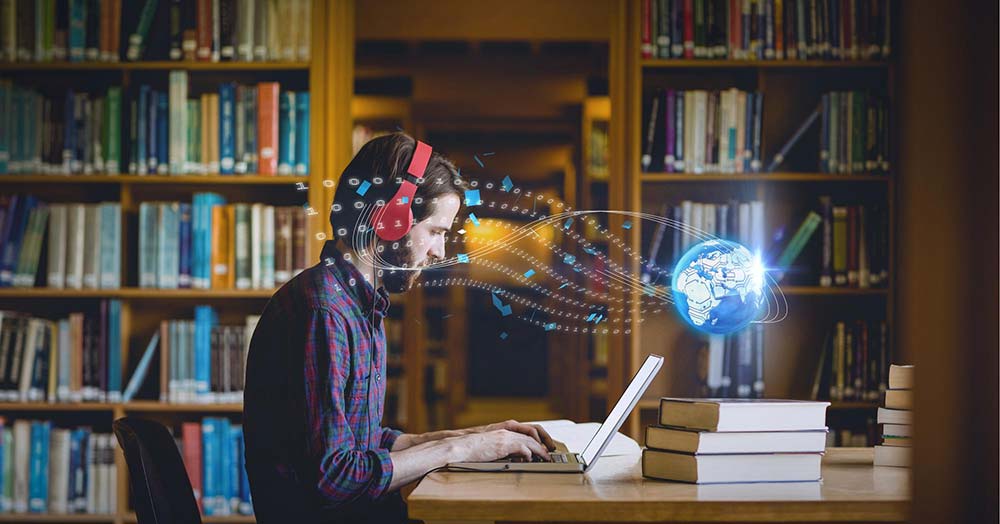
In my agency work with edtech startups, I’ve seen how artificial intelligence in learning nurtures curiosity. Students no longer depend on static notes—they learn to think critically, interact with data, and refine how they question. This mirrors today’s digital environment, where SEO in the age of AI is evolving to reward better questions rather than repetitive answers.
AI is not just enhancing academic performance; it’s transforming the learning mindset. By blending automation with personalisation, it empowers both teachers and students to focus on creativity, application, and lifelong learning. As technology and creativity converge, industry leaders are redefining how education connects to real-world skills. Reflecting on this evolution, Anuj Mahajan shares his perspective:
While serving the broadcast and communication industry for over 32 years, my team at Nuteq and I have witnessed firsthand how AI is bridging the gap between education and employability. The focus is steadily shifting from rote learning to real understanding. Through our Knowledge Hub we redefine how students learn and grow.— Anuj Mahajan, Co-Founder, Trendvisionz
Real-World Classroom Applications of AI
Across India and beyond, teachers are using AI to personalize lessons and make learning interactive. Here are my favourite five Practical Tools Empowering Classrooms:
- Leverage Edu AI Platform – Uses artificial intelligence to guide students in personalized learning pathways.
- Khanmigo (Khan Academy) – An AI
- Khanmigo (Khan Academy) – An AI tutor that offers step-by-step problem guidance.
- Eduaide.ai – Helps teachers create assessments, assignments, and personalized lesson plans.
- MagicSchool AI – Simplifies administrative work for schools while improving content delivery.
- TeacherMatic – Indian-specific platform automating teacher workflows and compliance modules.
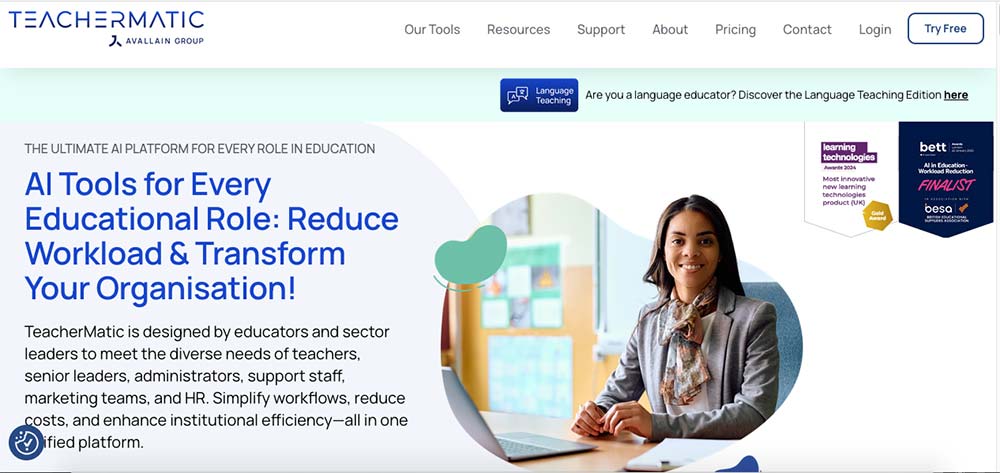
AI in classrooms is no longer futuristic—it’s the invisible assistant supporting both teachers and learners every day.
Takeaway: AI tools for students make learning more personalised, measurable, and meaningful—bridging gaps between traditional education and the skills required for a technology-driven future.
Beyond STEM – AI Applications in Commerce and Arts
AI is no longer confined to coding labs. It’s reshaping how creative and business disciplines function. For students in commerce and arts, AI is enabling sharper analysis, faster creation, and more immersive problem-solving across industries.
How Are AI Applications in Commerce and Arts Changing Learning?
Artificial intelligence is now integral to design, storytelling, and financial decision-making. The following examples highlight where innovation meets intuition in today’s classrooms:
- Financial Forecasting: Students use AI-driven analytics to predict markets, assess risks, and build smarter investment models.
- Creative Storytelling: Tools like ChatGPT and Runway help writers and designers co-create scripts, visuals, and campaigns with greater speed.
- Design Thinking: Generative AI platforms such as Midjourney and DALL·E help transform ideas into prototypes and creative concepts in minutes.
- Audience Insight: Predictive algorithms support marketing students in understanding trends and personalising brand messages.
- Cross-Disciplinary Collaboration: As noted in Global Education Trends: Student Immersion Programs, AI now drives experiential projects where art meets analytics and commerce meets creativity.
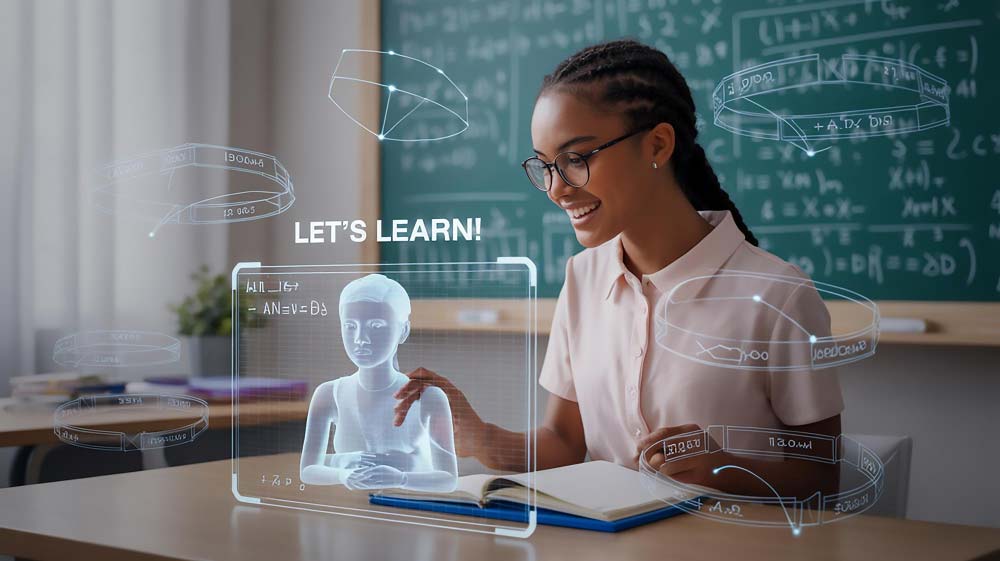
Over the years with each passing trends, I’ve seen how AI applications in commerce and arts cultivate curiosity and confidence. Students learn to treat AI not as automation but as collaboration — a partner that enhances, not replaces, human skill.
How AI Is Fueling Creativity Beyond STEM
Creative students now use AI to tell stories, design brands, and visualize ideas faster.
AI Tools Empowering Arts & Commerce Students:
- Canva Magic Write – Generates design ideas, captions, and marketing content for creative projects.
- Runway ML – Enables video editing, motion design, and AI-assisted storytelling for visual arts.
- Synthesia – Converts written scripts into videos, making learning and presentations interactive.
AI is turning imagination into collaboration—helping every creator move from concept to creation with speed and precision.
Key Takeaway: AI for students in non-STEM fields bridges logic and imagination. It empowers future professionals to move from traditional learning to applied innovation, where data supports creativity and every idea is measurable, meaningful, and human.
AI Literacy – The New Core Skill for Global Education
Across the world, universities are realising that AI literacy is no longer optional. It’s the skill that connects creativity, analysis, and employability. AI literacy and digital adaptability mean understanding how technology thinks, questions, and learns—so that students can use it responsibly and effectively.
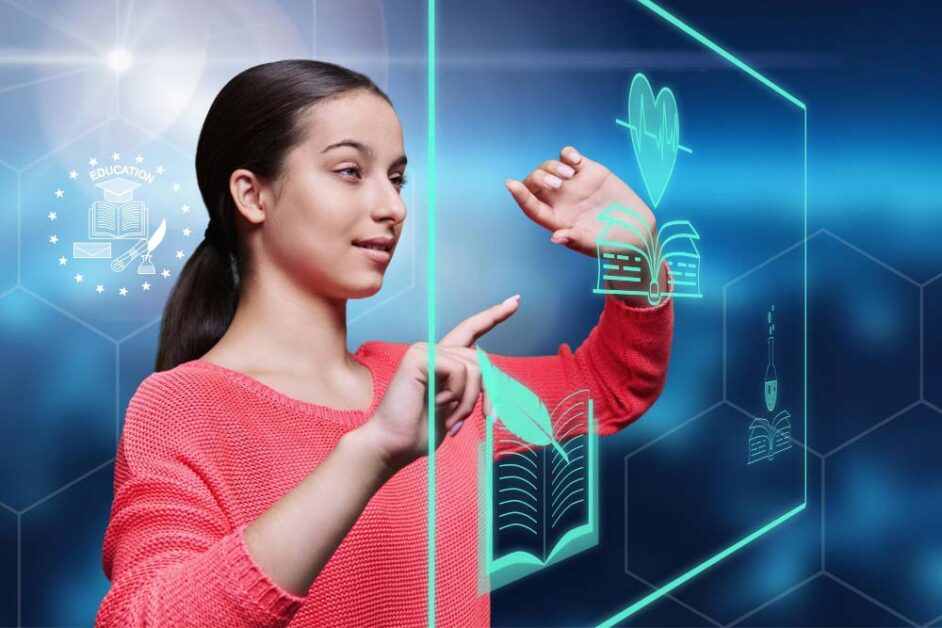
UNESCO’s digital education framework urges institutions to close access gaps and teach ethical AI use early. The goal is simple: students should not just consume information but interpret data, spot bias, and design fairer systems.
UNESCO’s framework for AI-ready education
- Promote equal digital access for all learners.
- Encourage transparent and ethical AI practices
- Support teacher training in AI-enabled pedagogy.
- Foster responsible innovation in classrooms.
- Bridge gender and socio-economic gaps in technology adoption.
Classrooms that integrate machine learning in education are already seeing stronger participation and better problem-solving outcomes. This shift is visible in global benchmarks too. As explained in gold standards- QS Rankings, universities that combine innovation and AI integration are now scoring higher for research quality and employability.
Components of AI literacy
- Digital Awareness: Understanding how algorithms, data, and automation influence daily life.
- Critical Thinking: Questioning AI outputs and validating information sources.
- Ethical Understanding: Recognising bias and promoting responsible technology use.
- Collaboration Skills: Working effectively with AI systems and diverse teams.
- Adaptability: Learning continuously as tools and technologies evolve.
From my work with international education clients, I’ve seen that once students engage with AI intentionally, they gain confidence across disciplines. They use it not to replace thinking but to expand it—bridging human creativity with digital intelligence.
Key Takeaway: AI literacy has become the new academic baseline. It prepares students to question intelligently, adapt confidently, and thrive in a technology-driven world.
Building AI Skills Step by Step
Developing AI skills doesn’t require a computer science degree — it begins with curiosity, consistency, and the willingness to experiment. Students today can build a strong AI foundation by combining structured learning with real-world application.
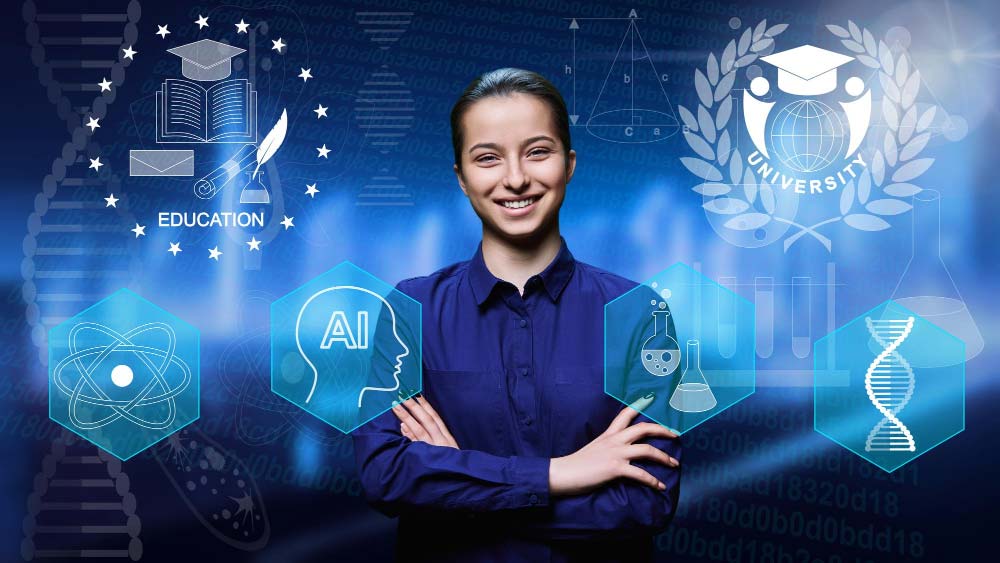
AI literacy follows the same growth mindset students apply in digital marketing and content automation. As discussed in SEO Is Dead?, success comes from adaptation — testing, learning, and refining with each iteration.
Four-week Roadmap to get started with AI tools for students
- Week 1️⃣ – Explore Tools: Try ChatGPT, Gemini, or Notion AI to understand different capabilities.
- Week 2️⃣ – Practice Prompts: Learn how to write effective prompts for writing, research, or ideation tasks.
- Week 3️⃣ – Build Mini Projects: Apply tools in a subject assignment or group project to improve output quality.
- Week 4️⃣ – Reflect and Refine: Evaluate results, identify errors, and document learnings to track personal progress.
I can clearly say with my experience, students who document their AI learning journey stand out in internships and interviews. Employers don’t just look for tool knowledge — they value mindset, adaptability, and problem-solving.
Key Takeaway: Start small, stay curious, and build steadily. Consistent exploration of AI tools transforms learning into measurable, career-ready skill growth.
Global Mobility and AI-Driven Careers
AI has become the new language of opportunity across borders. Students who master it gain an edge in global classrooms and workplaces. AI career opportunities are now central to international education and employability, reshaping how universities and industries collaborate worldwide.
How AI skills increase global employability:
- Tech-Enabled Roles: Knowledge of AI and data tools is now essential in finance, healthcare, marketing, and logistics.
- European Integration: As shown in Facts About Malta, hubs like Malta are embedding AI in academic and industrial sectors, creating cross-border research and work opportunities.
- Study Abroad Advantage: Study Abroad Trends 2025 notes Indian students increasingly selecting AI-driven programs to stay globally competitive.
- Cultural Adaptability: Students skilled in AI tools communicate and collaborate more effectively across multicultural environments.
- Career Growth: AI-trained graduates are landing roles faster as global employers prioritise automation literacy and digital creativity.
Immersion education powered by AI is transforming how students experience global learning. It’s no longer about studying abroad—it’s about connecting ideas, industries, and innovation through intelligent collaboration. AI enables every learner to build global competence before they even step on a plane — Zahoor Sofi, CEO & Founder, Value ADZ Global

These insights reflect what I’ve consistently observed through TrendVisionz’s education collaborations worldwide. Students with AI-led immersion programs develop sharper cultural intelligence, stronger problem-solving skills, and the confidence to thrive in professional environments.
Key Takeaway: AI is redefining global mobility. For future-ready students, fluency in AI transforms academic learning into global credibility, opening doors to international research, innovation, and career success.
Also Read:
- SEO Is Dead? How AI Search Is Evolving User Behaviour
- Citizenship by Investment and Residency: The Rise of Global Indians in 2025
FAQs: AI in Education
What are the main ethical challenges of using AI in education?
Key concerns include plagiarism, data bias, and privacy risks. Responsible use of AI demands transparency, human supervision, and ethical awareness among students and educators to maintain accountability and academic integrity. These concerns are echoed in global research4, who emphasize that balancing innovation with ethical governance is essential.
What are the three paradigms of AI in Education?
AI in education evolves through three paradigms: AI-Directed (learner as recipient), AI-Supported (learner as collaborator), and AI-Empowered (learner as leader), where students gain agency while AI offers adaptive, actionable feedback to enhance learning.
How is AI reimagining your child’s classroom?
AI is transforming classrooms into personalized learning spaces. It adapts lessons to each child’s pace, supports teachers with smart tools, encourages creativity, and ensures every student gets equal access to engaging, data-driven education.
Before We Go
AI in education is redefining how students learn, create, and grow into innovators. It connects disciplines, enhances critical thinking, and builds the future-ready skills employers value worldwide. For every learner, the message is clear—start early, stay curious, and apply technology with purpose5.
At TrendVisionz, we empower students and professionals with insights that drive digital transformation and real-world success. Explore the future of learning, upskill with AI for students, and unlock smarter pathways to global careers.
The time to act is now—your transformation begins with TrendVisionz.
Additional Resources
- UNESCO. (2024). Artificial intelligence in education: Supporting Member States to harness AI for achieving the Education 2030 Agenda. UNESCO. ↩︎
- World Economic Forum. (2025). The Future of Jobs Report 2025. Geneva: World Economic Forum ↩︎
- MDPI. (n.d.). Journal of Artificial Intelligence in Education (JAIED). MDPI. Retrieved October 23, 2025 ↩︎
- Bhattacharjee, S., Ahmed, M., & Rahman, S. (2024). Artificial intelligence in education: A comprehensive review of emerging trends and ethical challenges. Decision Support Systems, 183, 105413. https://doi.org/10.1016/j.dss.2024.105413 ↩︎
- Springer. (n.d.). AI & Society. Springer. Retrieved October 21, 2025. ↩︎
Stay Connected with Me
Anshuman Mahajan is a Digital Marketing Strategist, SEO Specialist, and Co-Founder of TrendVisionz. With expertise in ROI-focused growth strategies, brand development, and media solutions, he helps businesses navigate the fast-changing digital landscape with clarity and confidence.
- Explore my work: TrendVisionz | Nuteq Entertainment
- Read our newsletters: BizTech Chronicle
- Guest writer: BizCatalyst360 | Industry Blogs
- Courses & Certification: B.Com (Hons), University of Delhi | Digital Marketing (Shaheed Sukhdev College of Business Studies) | SEO Internship, ClickSlice (London)
- Join the community: LinkedIn Group – Digital Marketing & Content Creation World
- Connect with me: LinkedIn | BizTech Chronicle | #GrowWithAnshuman
- Share your review: Leave your feedback on Google — it helps us grow.
- Subscribe: Be part of our 1.95 Lakh+ YouTube family
Believe. Transform. Succeed. Let’s grow together.



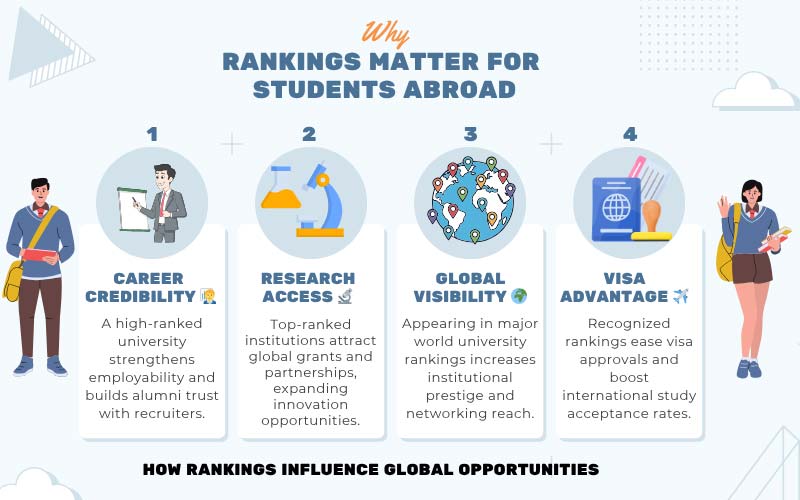

4 comments
[…] Posts From Arts to Commerce: How AI in Education Shapes Every Student’s… Women Travellers in India: How Empowering Journeys Are Transforming Tourism Burnout to […]
When discussing Sleep Disorders, it’s essential to consider how daily routines and consistent habits shape a child’s future. Parents can play a major role by offering patience, structure, and encouragement that helps their child grow both mentally and emotionally. When discussing Sleep Disorders, it’s essential to consider how daily routines and consistent habits shape a child’s future. Parents can play a major role by offering patience, structure, and encouragement that helps their child grow both mentally and emotionally.
appreciate the feedback
There is definately a lot to find out about this subject. I like all the points you made
Comments are closed.